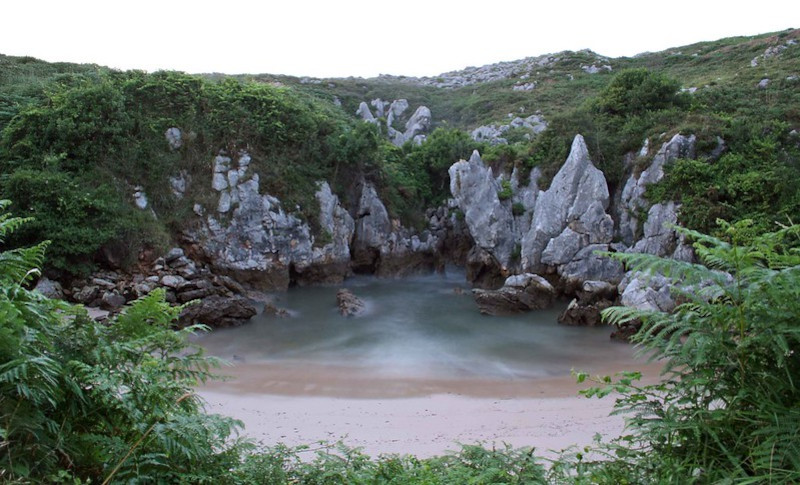Playa de Gulpiyuri Facts
- The simple term of Playa de Gulpiyuri serves as the name for a truly astounding creation of natural forces. The word gulpiyuri roughly translates into english as water circle. It names a site that ranks as one of the smallest yet most amazing of all beaches.
- Incredibly, the astounding site actually represents an inland beach. Astonishingly, though, it’s not one accompanying a river. This remarkable geological feature formed located near what now represents the region of Llanes, in the country of Spain.
- This lies on the northern coast of the country, and also forms part of what’s now Spain’s Regional Network of Protected Areas. Not surprisingly, the marvel of Nature even holds the distinction of having been named a natural monument, as well.
- Playa de Gulpiyuri also, though quite understandably, now represents an extremely popular tourist attraction across the region. However, the breathtaking site can be extremely difficult to locate and reach. That condition actually helps to preserve it.
- The formation represents one of the few known hidden beaches in the world. But that’s not its sole claim to fame. Even within such rarefied circles, most experts believe this formation to be the only one of its kind on earth that has a fully tidal nature.
Related Articles
Playa de Gulpiyuri Physical Description
Given its many defining characteristics, Playa de Gulpiyuri naturally amazes those few fortunate enough to pay it a visit. The site manages to do so due to a combination of factors. That’s the blending of its unique nature and its remarkable visual appeal.
The remarkably picturesque and completely unique creation of natural forces truly stands out. That’s true given the fact that the marvel also constitutes perhaps the smallest ocean beach on earth. That’s principally due to the nature of its formation.
Despite its other incredible statistics, the beach only measures roughly 131 ft (40 m) in length. Meanwhile, its width just averages about 65.5 ft (20 m) when the tide is at its lowest. Not stopping there, the site also formed a mere 328 ft (100 m) from the Cantabrian Sea.
These facts only serve to augment the extraordinary natural charm and wonder it presents to the visitor. This simply provides further proof that tiny can be beautiful. Yet it also merits appreciation due to its unprecedented connection the efforts of local tides.
The reason for its fully tidal nature remains the existence of a network of small underground tunnels connecting it to the ocean. This amazing direct link to its source provides another marvel. It actually allows for the creation of minor wave activity.
The uniqueness of this wonder of Nature does not end there, though. That’s because Playa de Gulpiyuri also sits tucked away in a small hollow area, set into the ground. This hollow region itself lies almost perfectly in the center of a lovely green meadow.
Playa de Gulpiyuri Formation and Preservation
As its presence in Spain shows, the stunning Playa de Gulpiyuri originated within the greater boundaries of the continent of Europe. In itself, that’s no great surprise. That’s understandable since this region of the world is renowned for its abundance of marvels.
At its origin, though, it actually formed due to the intriguing combination of two separate natural events. The rarity of this action perfectly serves to give it a completely unique distinction. In fact, only a handful of even vaguely similar sites exist in the entire world.
Uniquely, the endless activity of the ocean waves carved several small tunnels into the sea cliffs over a great period of time. Then, although scientists remain uncertain of when it happened, a naturally occurring sinkhole formed, creating the magnificent site.
Eventually, the relentless motion of the ocean waves augmented what had begun, creating Playa de Gulpiyuru as we currently know it today. That’s because their implacable movements washed away the debris and deposited sand, and thus the beach was formed.
Thankfully for conservationists, the site is not widely advertised, to help protect it in its current condition. Tourists from around the world visiting the area hear about it from local inhabitants, however. These frequently inundate it during warmer parts of the year.
Features Sharing Its Region
Check out our other articles on 6 Mysterious Natural Phenomena, Golden Pheasant, Bay of Islands, Waterwheel Plant, Gharial, Dragon Moray Eel, Goldsmith Beetle, Purple Frog

